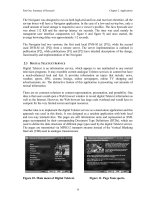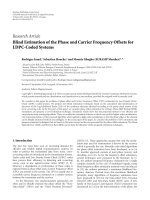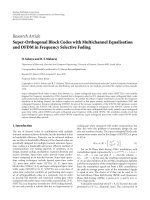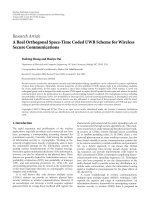Digital Television Techniquies Coded Orthogonal Frequency Division
Bạn đang xem bản rút gọn của tài liệu. Xem và tải ngay bản đầy đủ của tài liệu tại đây (712.67 KB, 34 trang )
1
Digital televsion techniques – Lecture 7
Lecture 7
Digital television
Coded Orthogonal Frequency Division
Multiplexing
• Need for a good transmission technique
• Explanation of the different parts
• Coded
• Frequency Division Multiplexing
• Orthogonal
1
2
2013 Digital televsion techniques – Lecture 7
DVB-S
2
3
2013 Digital televsion techniques – Lecture 7
DVB-C
3
4
2013 Digital televsion techniques – Lecture 7
DVB-T
4
5
2013 Digital televsion techniques – Lecture 7
DVB-S/C/T Comparison
S C T
Energy dispersal
X X X
Outer coding (Reed-Solomon (204,188))
X X X
Outer interleaving
X X X
Byte to m-tuple conversion
X
Differential encoding
X
Baseband shaping / QAM modulation
X
Inner coding
X X
Inner interleaving
X X
Mapping and modulation (QAM / QPSK)
X X
OFDM
X
5
6
2013 Digital televsion techniques – Lecture 7
Design goals for digital terrestrial
video broadcasting
• Single Frequency Network (SFN)
• Mobile reception
• Problems
• Multipath interference - ghosts
• Noise interference – snow
• Variable path attentuation – fading
• Interference to existing services
• Interference from other services
6
7
2013 Digital televsion techniques – Lecture 7
• Developed by the digital video
broadcasting project group - DVB
• Uses similar technology to DRB (DAB)
• Uses 1705 or 6817 carriers
• Variable carrier modulation types are defined allowing data rates of 5-27
Mb/s in 7 MHz
• Developed for 8 MHz channels
– A 7 MHz variant has been produced and tested
• Can use single frequency networks - SFNs
• New technology with scope for continued improvement & development
Mobile reception
7
8
2013 Digital televsion techniques – Lecture 7
• BST-OFDM is a variant of the European COFDM
system which allows segmenting of the data spectrum
into 100 kHz blocks.
• 2 receiver bandwidths proposed.
– 500 kHz portable / mobile for sound and data
– 5.6 MHz fixed / mobile for SDTV and LDTV
– 5.6 MHz fixed for HDTV
• Individual band segments can be allocated to separate
services which can use different modulation systems
BST OFDM Japan
8
9
2013 Digital televsion techniques – Lecture 7
• Existing analog TV channels are spaced so they do not interfere
with each other.
• Gap between PAL TV services
– VHF 1 channel
– UHF 2 channels
• Digital TV can make use of these gaps
Ch 7
Ch 8
Ch 9
Ch 6
Ch 9A
VHF Television Spectrum
Channel spacing
9
10
2013 Digital televsion techniques – Lecture 7
• Digital TV must co-exist
with existing PAL services
– DTV operates at lower power
– DTV copes higher interference levels
– Share transmission infra-structure
– DTV needs different planning methods
Ch 7
Ch 8
Ch 9
Ch 6
Ch 9A
VHF Television Spectrum
8-VSB COFDM
Digital challenges
10
11
2013 Digital televsion techniques – Lecture 7
The effect of a multicarrier system
11
12
2013 Digital televsion techniques – Lecture 7
Mathematical description of COFDM
Each carrier is modulated
Several carriers are summed
For one symbol duration
Fixed values for phase, amplitude
12
13
2013 Digital televsion techniques – Lecture 7
…Mathematical description of COFDM
Zeroth frequency = 0 gives
Compare with IFT
Equivalent if
13
14
2013 Digital televsion techniques – Lecture 7
Visualization of COFDM
14
15
2013 Digital televsion techniques – Lecture 7
Modulation of subcarriers
15
16
2013 Digital televsion techniques – Lecture 7
COFDM principle
16
17
2013 Digital televsion techniques – Lecture 7
Frequency
Minimum
Carrier Spacing
Traditional SCPC Modulation
17
18
2013 Digital televsion techniques – Lecture 7
COFDM Orthogonal carriers
18
19
2013 Digital televsion techniques – Lecture 7
COFDM Orthogonal carriers
19
20
2013 Digital televsion techniques – Lecture 7
6.67 MHz in 7 MHz Channel
Almost
Rectangular
Shape
1705 or 6817 Carriers
Carrier Spacing
2k Mode 3.91 kHz
8k Mode 0.98 kHz
Spectrum of COFDM
20
21
2013 Digital televsion techniques – Lecture 7
Subchannel response - pilots
21
22
2013 Digital televsion techniques – Lecture 7
Subchannel response - pilots
22
23
2013 Digital televsion techniques – Lecture 7
Subchannel response - pilots
23
24
2013 Digital televsion techniques – Lecture 7
Analog
Digital
Good
Rotten
Close Far
Distance
Quality
Edge
of
Service
Area
System failure characteristics
24
25
2013 Digital televsion techniques – Lecture 7
COFDM parameters
• Carrier modulation: 2k, 8k
• Type of modulation QPSK, 16QAM, 64QAM
• Guard interval ¼, 1/8, 1/16, 1/64
• Inner coder puncture rates: ½, 2/3, ¾, 5/6, 7/8
• Hierarchical modes
• Selection of transmission bandwidth (6/7/8 MHz)
25









